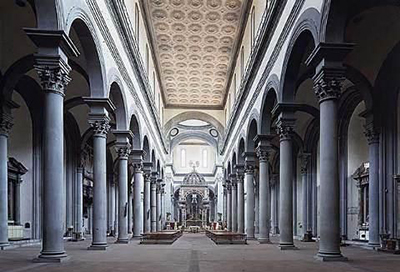Church of Santo Spirito, arguably the most famous corner of the Oltrarno, is a perfect Renaissance architectural harmony example and among the most attractive churches in Florence, Italy.
It was designed by Filippo Brunelleschi; he started the designs for the church as early as 1428. Brunelleschi followed a very strict geometrical plan to design a perfection of forms plus proportion. The first pillars of the church were delivered in the year 1446, ten days before he died. After he died, the works were continued by his followers Giovanni da Gaiole, Antonio Manetti and Salvi d'Andrea; also, the latter was responsible for the cupola construction.
Unlike Basilica di San Lorenzo, where the ideas of Brunelleschi thwarted, here, Brunelleschi's ideas were followed with some level of fidelity, in the ground plan as well as up to the arcades level. The Latin cross plan was designed like that to maximise the grid legibility. Also, the contrast between transept and nave that caused the difficulty at Basilica di San Lorenzo, was avoided. The chapel sides, in niches form, which is all the same size, run along the whole perimeter of the space.
The facade that Brunelleschi designed was never built, it was left blank and plastered over later. In the year 1489, an octagonal sacristy and columned vestibule designed by Giuliano da Sangallo and Il Cronaca (Simone del Pollaiolo) respectively, were built, this was to the left side of this building. A door was then opened up in the chapel to make the link to the church.
In 1601, Gherardo Silvani and Giovanni Battista Caccini added a Baroque baldachin that has polychrome marbles over the high altar. The Church of Santo Spirito remained undecorated until the eighteenth century when its walls were plastered. Salvi d'Andrea designed the inner façade, and it still has the original window (made of glass) with the Pentecost that Pietro Perugino designed. Baccio d'Agnolo designed the bell tower in 1503. The exterior of this building was restored in the year 1977-78.
The Church of Santo Spirito is characterised by columns dividing the church into 3 aisles, and they surround the high altar, similar to S. Lorenzo. On the side walls, there are pilasters and the building has a coffered ceiling, which wasn't part of the building's original design. Brunelleschi designed the ceiling to be left open for a beautiful image of the walls that reach up to the heavens. That was, and it still is, a classic design by Brunelleschi: a cavernous but still harmonious space. As Brunelleschi did in S. Lorenzo church, the classic mathematically symmetric architecture was emphasised by dark grey pietra serena stonework and white walls. Moreover, more emphasis was added using the colour contrast: the stone beautifully stretches in arches from a column to the next one.
Notably inapposite, is a fanciful carved, ornate, and a high altar Baldacchino that's statue-studded, a baroque work dating from the early seventeenth century. Between the mid-late 1400s, the battle of the pulpits occurred here. It was between a Dominican friar known as Savonarola, who for a while used to be a great influence, especially on the civic and religious affairs of Florence as well as Mariano da Genazzano, a public Girolamo Savonarola opponent who spent his life studying the Augustine teachings.
When people are walking around the outside of this church, they'll be struck by its stark appearance: there are no decorations like those of San Miniato or Santa Croce, or ornamentation and pillars like that seen in Santa Trinita. However, it wasn't left unfinished like S. Lorenzo. Alongside the building's exterior wall, the coats of arms are seen over the windows. They belonged to those families whose chapels are seen on the other side of these windows. The actual façade is typically from 1792, and it was decorated mainly with painted architectural detailing, which was later removed in the sixties during restoration work.
Brunelleschi envisioned all the sides of this church flanked with a loggia, same as that seen at Innocenti Museum located in Piazza Santissima. However, it did not come about as that would have required the façade to be changed. Also, Brunelleschi originally wanted the piazza and church facade to overlook the 241-kilometre river Arno, but it was not possible to purchase all the property that was on the other side because not everyone was willing to sell the property. The interior of the church hosts a wealth of attractive pieces of artwork. A stroll through the Santo Spirito church plus the abundant natural light, definitely makes it easy to acknowledge the beauty within. The pieces in the church include works by Andrea Orcagna, Michelangelo and Perugino.
The Church of Santo Spirito has a history that is unique. The Augustinian monastery that is annexed to this church used to be a meeting place for scholars. The early humanists met here: both Giovanni Boccaccio and Francesco Petrarca were regular guests in this church. Giovanni left the library he had to the convent. The earlier church provided hospitality to an eighteen-year-old Michelangelo (an Italian architect, painter, sculptor plus poet of the High Renaissance) after the death of Lorenzo Il Magnifico (his patron). The church allowed Michelangelo to dissect as well as study the bodies that were coming from the hospital of the convent. Studying human anatomy was an essential part of the education of an artist. In exchange for that privilege, he sculpted a wooden crucifix visible in the Sacristy. It is a frail, languid adolescent Christ, far from the powerful figures that the artist worked on later, but quite touching in his vulnerability.




